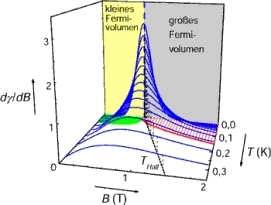| A quantum critical point (QCP) develops in a material at the absolute zero in temperature when an order parameter
is continuously suppressed to zero by variation of a non-thermal tuning parameter such as pressure, magnetic field or chemical composition.
QCPs are of great current interest because of their singular ability to influence the finite temperature properties of materials.
Recently, heavy-fermion metals have played a key role in the study of antiferromagnetic QCPs.
Our recent investigations have focussed on several systems:·
- YbRh2Si2 (image): The Néel temperature of only 70 mK of this heavy-fermion antiferromagnet
is continuously suppressed by application of small magnetic fields. Measurements of the Hall effect indicate a collaps of the Fermi
surface at the QCP, calling for entirely new theoretical descriptions. In collaboration with MPI CPfS Dresden.
- Yb2Pd2(In1-xSnx): The phase diagram of this series of compounds is
characterized by the observation that both end members do not show long range magnetic order. Magnetic instabilities, however,
develop in a narrow concentration range for compounds rich in Sn. This particular feature enables the occurrence of two QCP’s
within a single series of compounds. Such a feature was never found before in cerium or ytterbium based heavy fermion systems and allow to
study non-Fermi liquid phenomena on two distinct different sites of a magnetically ordered regime. In co-operation with University of Genova.
- CeNi9Ge4 shows unusual non-Fermi liquid behaviour of the specific heat over at least two decades in temperature with
a record value of the electronic specific heat coeficient γ at low temperature: γ ~ 6 J/molK2 at 80mK in this system without any sign of magnetic
order. The ground state properties are currently studied by neutron and muon spectroscopy and single crystal investigations.
- LaCo9Si4 and YCo9Si4 exhibit itinerant electron metamagnetism and weak itinerant ferromagnetism,
respectively, both being very close to a ferromagnetic quantum critical point. Current focus is on single crystal growth and high pressure studies.
|
Field-induced quantum critical point
of YbRh2Si2

Fig.1: Upon increasing the magnetic field B antiferromagnetism (green area) is continuously suppressed to
zero at the QCP of 0.7 T. At higher fields Landau Fermi liquid behaviour is observed (red hatched area).
Non-Fermi liquid behaviour is found in a large area above the QCP. dγ/dB represents the rate of change of the Hall coefficient.
In the limit T=0 the Hall coefficient jumps discontinuously from a large value (small Fermi volume) to a small value (large Fermi volume).
[after: Paschen et al., Nature 432 (2004) 881]
|


